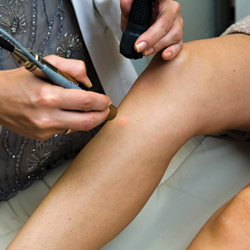
The demographics of the aging baby boom population and their offspring has provided the incentive for the growth of the medical spa industry in the United States, and indeed throughout the world. Medical spas appear in the form of private centers in the offices of plastic surgeons and dermatologists, but also as freestanding centers as part of a franchise, as well as various salons and boutiques, and at many private resorts. Unfortunately, not all of these scenarios provide the minimum standard of medical care and may have little or no medical supervision.
Problems with patient injuries have occurred when unsupervised treatment with lasers and the administration of injectable agents, including Botox, injectable fillers and other agents have occurred. A 2007 survey of the American Society for Dermatologic Surgery found that laser hair removal, for example, was the No. 2 procedure for which complications occurred, second only to the misdiagnosis of skin cancer. This included such problems as skin burns, pigmentary changes and scarring, as well as ineffective results.
Other surveys have confirmed that about 80 percent of all complications from laser hair removal and other light-based therapies occur in facilities that have no direct physician supervision or in which the “medical director” had limited training in these procedures. These were almost all non-traditional medical facilities such as free-standing medical spas and laser centers in shopping malls. In other facilities, non-physician and non-medical personnel have been allowed to perform cosmetic injections, including injectable fillers and Botox, as well as non-FDA approved procedures, including mesotherapy and carboxytherapy, for example.
What has precipitated this situation? On a very basic level, it is the law of supply and demand. At the same time, state legislatures, until recently, have been slow to pass regulations protecting the consumer from what amounts to the unregulated practice of medicine in many unsupervised facilities.
Fortunately, the Illinois Department of Financial and Professional Regulation has added new rules under the Medical Practice Act regarding the use of lasers in physician practices, effective March 19, 2009. These regulations, not commonly appreciated by the general public, stipulate the following:
- A physician must examine the patient prior to any laser procedure.
- Ablative laser procedures require on-site physician supervision.
- Non-ablative laser and light-based procedures require the physician to be available on-site or by telephone or other electronic means.
- Any person delegated the authority to perform any laser procedure must have appropriate documented training and education in the safe and effective use of each system utilized.
In addition, consumers are advised to utilize facilities where there are on-site physicians trained in plastic surgery or dermatology, or where such individuals are immediately available. Consumers should also be able to verify that nurses, aestheticians and other personnel performing aesthetic procedures have adequate training and experience and documentation of both.
Finally, consumers visiting medical spas must understand the distinction between non-invasive procedures, such as waxing, facials, massages and light peels, and more aggressive procedures including intense pulsed light (photofacial) and laser procedures, and injectable fillers and neurotoxins such as Botox and Dysport. These are not “beauty treatments,” but are, in fact, medical procedures requiring the appropriate expertise and training. Anyone performing such procedures should not only have the training and expertise to skillfully perform them, but also to manage any unwanted side-effects or complications. iBi
Harrison C. Putman III, M.D., FACS, is the medical director of the Facial Plastic and Laser Surgery Center in Peoria, Illinois.

